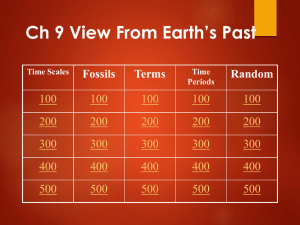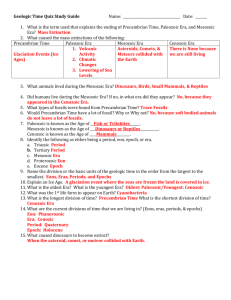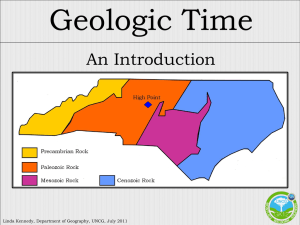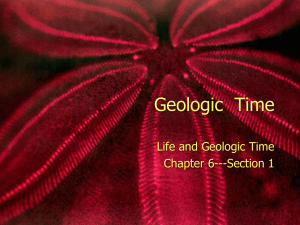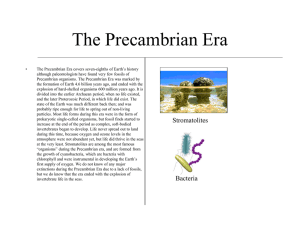File
advertisement
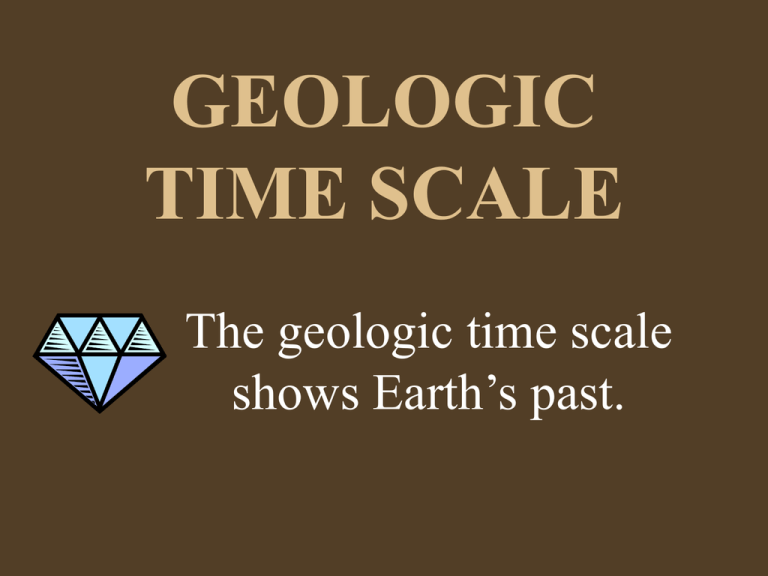
GEOLOGIC TIME SCALE The geologic time scale shows Earth’s past. What is Uniformitarianism? • Uniformitarianism: – Is a theory developed by the Scottish geologist, James Hutton, in the late 1700’s – Is the idea that the Earth is an alwayschanging place – Is the idea that the same forces of change at work today were at work in the past The GEOLOGIC TIME SCALE is a record of the history of the Earth, including geologic events and changes in life forms. How is the geologic time scale divided? • The geologic time scale is divided into four parts: – EONS • ERAS – PERIODS » EPOCHS What is the largest unit of time in Earth’s history? • The largest unit of time is an eon. • Earth’s 4.6 billion year history is divided into four eons. • Three out of the four eons are grouped together to form the Precambrian Time What is the Precambrian Time? • The Precambrian time represents 90% of the Earth’s history. • The Precambrian time began 4.6 billion years ago and ended 544 million years ago. It lasted about 4.05 billion years. • The Precambrian Time is so long because there is very little evidence (fossils, etc.) to determine any changes in geology or in forms of life. The other 10% of the Earth’s history was divided into segments (eras, periods, and epochs) based on changes (evolution) in life forms. Geologists use the Geologic Time Scale to organize the Earth’s history. Each era, period, and epoch is based on major changes in life forms. The most recent eon, the Phanerozoic, is divided into three eras: • Paleozoic • Mesozoic • Cenozoic What does Paleozoic mean? Paleozoic means ancient life. Paleo = Ancient Zoic = Life What does Mesozoic mean? Mesozoic means middle life. Meso = Middle Zoic = Life What does Cenozoic mean? Cenozoic means recent life. Ceno = Recent Zoic = Life Earth’s Geologic History The Precambrian began 4.6 BILLION YEARS AGO and ended 544 million years ago. In the beginning of the Precambrian Time the Earth was still cooling from the collision between the proto-earth and a massive asteroid that formed the Earth and the Moon. The Earth was covered with volcanoes that spewed out water vapor that would eventually condense and form the Earth’s oceans. The first life on Earth appeared in the seas about 3.5 billion years ago. These early life forms were single-celled organisms, such as cyanobacteria (blue-green algae). Later in the Precambrian Time multi-cellular organisms, such as jellyfish, appeared. The end of the Precambrian Time is marked with an explosion of life. This is the beginning of the Paleozoic Era. The Paleozoic Era began 544 million years ago. The Paleozoic Era is known as the Age of INVERTEBRATES (Animals without backbones). The first part of the Paleozoic Era is called the CAMBRIAN period. During the Cambrian Period there is a Great “explosion” of invertebrate life in the Earth’s seas. This is called the Cambrian Explosion. The second part of the Paleozoic Era is called the ORDOVICIAN period. • The first vertebrates (animals with backbones) appear in the Ordovician Period. • The first vertebrate was the jawless fish. The third period in the Paleozoic Era is the SILURIAN Period Life appears on land. The first life on land included plants and insects. The fourth period in the Paleozoic Era is the DEVONIAN Period. This period is known as the Age of Fish. Sharks and fish with scales and bony skeletons become common. Also, during the Devonian Period Lungfish develop and the first amphibians reach land. The fifth period in the Paleozoic Era is the CARBONIFEROUS Period. During this time great swamp forests covered much of North America and Europe. These forest form the great coal reserves found on Earth today. The Paleozoic Era’s last period is the PERMIAN Period. • Reptiles become dominant on land. • Pangaea forms. The end of the Paleozoic Era is marked by the mass extinction of many marine invertebrates including the trilobite. The Paleozoic era ended 245 million years ago. The era following the Paleozoic is the Mesozoic era, which began 244 million years ago. The Mesozoic Era is known as the Age of Dinosaurs. The 1st period of the Mesozoic era is the TRIASSIC Period. • During the Triassic period the first dinosaurs evolved. • The first mammals appeared. It is believed they evolved from warm-blooded reptiles. The second period of the Mesozoic era is the JURASSIC Period. • During the Jurassic period the first birds appear, and flying reptiles appear. • Large dinosaurs, called sauropods thrive. • Pangaea is breaking apart. The third period of the Mesozoic era is the CRETACIOUS Period. •The first flowering plants appear. •The first snakes appear. •Dinosaurs dominate, including Tyrannosaurus rex and Triceratops. The extinction of the dinosaurs occurred at the end of the Mesozoic Era. No one is sure why they died out, but some scientists believe an asteroid impact caused the mass extinction. The Mesozoic era ended 65 million years ago. This marks the beginning of a new era. The era following the Mesozoic is the Cenozoic era. The Cenozoic Era is known as the Age of Mammals. The first period of the Cenozoic era is the TERTIARY Period. • During the Tertiary period the continents move into their present day positions. • The Rocky Mountains, Alps, Andes, and Himalayas form. • The first grasses appear. • Ancestors of humans evolve. The second period of the Cenozoic era is the Quaternary Period. • The Quaternary period stretches from about 2 million years ago to the present. • During the Quaternary period the Earth’s climate cooled, causing a series of ice ages. • Giant mammals flourish until the ice age ends about 10,000 years ago. • Modern Humans evolve about 100,000 years ago. The Cenozoic Era, Quaternary Period, & Recent Epoch has not ended. We still live in it today!!!




